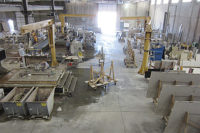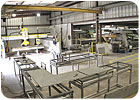
Southside Granite Co. of Dothan, AL, was founded in 1941 as a memorial manufacturing plant, and it has been fabricating countertops and architectural work since the early 1990s.
Established in 1941 by Jack Kingry and Coy Brunson, Southside Granite Co. of Dothan, AL, quickly became the most fully equipped memorial manufacturing plant within a 100-mile radius, serving customers in Alabama as well as Georgia and Florida. Today, the company remains in the memorial sector, and it also fabricates kitchen countertops and architectural stonework for a diverse client base.

Last year, the company upgraded its sawing capability with the addition of a GMM Rotex bridge saw from Italy, purchased from Salem Stone of Winston-Salem, NC.
Expansion into countertops
The initial 1941 partnership of Kingry and Brunson continued for nearly 30 years until Brunson’s passing in 1972. Work continued with the help of Kingry’s wife, Ella Mae, and Brunson’s widow, Lorraine.After Kingry’s retirement in 1991, the business remained in the family, as grandson Clyde Kingry - who started working with the company in 1978 at age 15 - partnered with Terry Pierce, who had earlier purchased the company. Today, Pierce serves as President, with Clyde Kingry serving as Vice President. Additionally, Clyde Kingry’s wife, Susan, works full time with the company and handles its day-to-day business operations, such as accounting, sales and purchasing.
“Terry first purchased the company from my grandfather, and then I purchased a share of the company from Terry almost immediately after that,” Clyde Kingry explained. “Terry is very much involved with the day-to-day operations of the company, while maintaining other business interests as well. It’s definitely a team effort.”
According to Kingry, the opportunity for expansion into the countertop market came at the same time of the purchase of Southside Granite. “It was about this time or shortly after that we first began to see interest in granite as a countertop material and received more and more calls for it over the next couple of years,” he said. “In 1993, I attended the International Tile & Stone Exposition [which later became Coverings], where we purchased the first profile router and diamond tooling from GranQuartz. It was a modified grinder mounted on a base plate with rollers. We used a rail saw that my grandfather had owned since the 60s to cut our first slabs.”
The company also began working with stone suppliers in the Southeast. “In search of a supplier for countertop material, we made contact with Bob Blastow of G&L Marble, who also helped get us up to speed on the current techniques used in fabricating ‘thin’ slabs, which we were not familiar working with,” Kingry said. “Previously, we’d only worked with 4- to 12-inch stock for cemetery memorials, most of which was granite quarried in the Elberton, GA, area or Georgia Marble quarried in Tate, GA. Everything we were used to - tooling, equipment, etc. - was on a much larger scale, so we really had to learn how to handle the 2-cm material. At that time, 3-cm material was not used as often as it is today. Transitioning to working with the typical 6- and 8-inch stock used for most memorials to working with the likes of 2-cm Rojo Alicante marble or Ubatuba granite presented a new learning curve for us.”
According to Kingry, the stone supplier proved to be a helpful source in learning slab fabrication. “Al Gardner of G&L Marble came to our shop for a day and demonstrated the use of Alpha hand polishing equipment and instructed us in fabricating techniques,” he said. “We had the background knowledge of many years of working with stone, so we learned quickly to adapt to the newer equipment. Even diamond resin polishing pads were new to us, since we’d previously only used carborundum cup wheels and felt buffing wheels with tin oxide to polish the Southern gray granites. After that, things moved along pretty quickly, with the tremendous growth and popularity of granite countertops that the whole industry experienced over the next 10 years or so.”
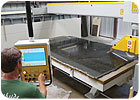
“We began to see a bottleneck in [sawing] production, especially since we’d added the second Intermac CNC machine,” explained Clyde Kingry, Vice President of Southside Granite. “The addition of the GMM Rotex, with its automated digital capabilities, helped to increase production in that area.”
Current operations
Southside Granite’s current scope of work includes the fabrication and installation of countertops, vanities, fireplace surrounds, tub decks, showers, stair treads, signs, plaques, and cemetery and public memorials. Materials being processed include natural stone as well as DuPont Zodiaq® quartz surfacing and Corian® solid surface.“From the beginning, most of our work has been custom high-end new construction,” Kingry said. “Most times, we are not stopping in the kitchen. We may install stone on almost every cabinet in the house and a fireplace or two, while also furnishing tile for flooring, showers, tubs - if not slab and backsplashes, sinks and faucets. We don’t install tile, but we are thinking about offering installation of backsplashes, since we have one installer with lots of experience.”
In addition to processing a range of stonework, the company also works with a range of client types. “A lot of times, we are working directly with the owners,” Kingry said. “However, we have also developed great relationships with some high-end builders, architects and designers that we move from job to job with. If their next project requires stone fabrication, and most do, then we are usually the company that will furnish it. We also work with some cabinet shops and small home centers who are resellers. We’ve never done a lot of tract or spec home jobs - except for a handful of high-end ones or for a small number of builders who are more concerned with quality and service than price.”
The remodeling sector has also been a growing portion of Southside Granite’s business. “In the recent past, remodeling work has caught up to - and in some cases surpassed - high-end new construction on our schedule,” Kingry said. “In these situations, we are almost always dealing directly with a homeowner. It may be only a kitchen countertop replacement or full-blown kitchen renovation project with contractors involved. The remodeling activity has helped to offset the decline in the new housing market.”
In a crowded remodeling market, Southside Granite has worked to make it stand out in terms of service. “In the remodeling projects, the owners are usually just wanting new countertops for their kitchen and/or master bath, and they come straight to us to get them,” Kingry said. “These situations require us to meet all of their needs, which may include helping them to line up a plumber or electrician when required. The key is to educate and develop the customer’s expectations from the beginning, guiding them through the entire process starting with stone selection. When this is handled right, there are usually no disappointments down the road for either party.”
On the non-residential end, the company has worked on a range of light commercial works. “We are continuously doing bank teller lines,” he said. “We’ve done natural stone and other surfaces in several fast food establishments in our area. We’ve been involved in several hotels, but only in the public areas, reception desk areas, dining areas and public restrooms - where the specifications are more customized. Granite signs for businesses, schools and public buildings as well as subdivision entranceways are also popular. Currently, commercial projects on our schedule include a Popeye’s franchise restaurant, upgrades at a local nursing home facility and an extensive renovation of Alabama’s Lakepoint Resort State Park.”
In addition to architectural stonework, the company also remains active in the monument sector. “We haven’t forgotten where we came from as we continue to personalize and install memorial work every day,” Kingry said. “For over 50 years, we built memorials from sawn slab stock all the way to final completion, but in more recent years have found it more feasible to let the large shops in Elberton handle most of the fabrication process. We still do most of the sandblast lettering and carving and some mild fabricating here in our memorial shop.”
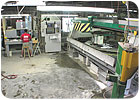
Southside Granite operates two Intermac Masterstone 2300 CNC stoneworking centers.
Stoneworking machinery and tooling
Southside Granite has continually been investing in new technology for its stoneworking operation. Included are two Intermac Masterstone 2300 CNC stoneworking centers. “We purchased our first CNC machine in 1996, and it is our understanding that we were among the first installations of a CNC stoneworking center by Intermac in this country,” Kingry said.Last year, the company upgraded its sawing capability with the addition of a GMM Rotex bridge saw from Italy, purchased from Salem Stone of Winston-Salem, NC. “We began to see a bottleneck in [sawing] production, especially since we’d added the second Intermac CNC machine,” Kingry explained. “The addition of the GMM Rotex, with its automated digital capabilities, helped to increase production in that area. We looked at the combination bridge saw/waterjet technology, but chose the more traditional type of bridge saw because we also have a need for cutting much thicker stone for memorial work.”
In terms of edgework, the company recently added a Beaver edge-chiseling machine from StonePro Equipment of Effingham, IL. “We’ve done chiseled edges a few times in the past by using the same hand tools that we used in rock pitching memorial work, and that got the job done,” Kingry said. “But the Beaver chiseling machine is just ideal for this type of edge work on 2-cm and up to 6-cm stone. It’s much quicker and produces a very consistent or irregular chiseled edge if you want.”
Stone is maneuvered around the shop using two overhead cranes with Abaco slab lifters as well as an Elephant jib crane with a vacuum lifter.
Other machinery in place at Southside Granite includes a Quincy rotary screw air compressor from Davis Dyer Equipment; Makita variable-speed electric grinders/polishers (9565CV and 9227CY); water-fed air polishers by Baranca Diamond and Alpha Professional Tools; Dewalt chop saws for trimming backsplash pieces; a Model J automatic sandblasting machine by Hirons; a Ruemelin sandblast generator and pnuematic abrasive recovery system; an Allen Datagraph plotter for template cutting; and an HIAB truck-mounted crane.
In terms of tooling and accessories, Southside Granite utilizes Diamut CNC tooling and 14-inch granite blades from Salem Stone; finger bits, core bits, CNC tooling and 5-inch Terminator blades from GranQuartz; 14-inch granite blades, 14-inch marble/onyx blades, 12-inch continuous rim blades and Metaflex polishing pads from Helix; Talon polishing pads from Braxton-Bragg; and 3-inch turbo polishing pads from JSST.
Among the more recent tooling investments, the company has added antiquing brushes from GranQuartz and Granite City Tool. “The somewhat newer textured finishes - leather, brushed or antiqued - are gaining in popularity with designers and homeowners,” Kingry said. “I really like the look of the textured surfaces, and it gives any particular stone a whole different appearance as opposed to the standard polished finish. When you take polished products and present them with a different texture that totally changes the look and feel of the stone, you immediately double the offering of selections available to designers and architects.”
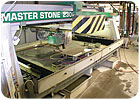
“We purchased our first CNC machine in 1996, and it is our understanding that we were among the first installations of a CNC stoneworking center by Intermac in this country,” Kingry said.
Implementing digital technology
According to Kingry, the advent of digital technology has been a major boost to the operation. “We are 100% digital in our operation,” he said. “We start with making digital templates with the ETemplate System, and the new sawing equipment we installed this past year is a digital cutting solution. The GMM Rotex uses the information that is produced by ETemplate System in a digital file format to saw the slabs. Before we replaced the manual saw, we still had to produce a physical template - even though we were already using a digital templating system. The sawyer had to use a mylar template cut by a plotter to line up on when making each cut, just like a stick template. This is no longer necessary. All that is needed is to import a standard DXF file into the software of the machine for cutting. You then simply manipulate each part on a touch-screen overlay of the slab photo and start the saw.“The advantage here is obvious, but the most important thing that this gives us - that we didn’t have before - is a much more accurate part coming off the saw,” Kingry continued. “Our saw is going to cut it perfectly.”
Kingry said that the ETemplate System has performed well for a variety of complex work. “One project of interest is a wet bar countertop where the customer wanted the same radius on the countertop as the ceiling overhead,” he said. “So we shot the cabinet and the overhead radius with markers up the wall between the two to help tie the two parts of the project together. We were able to capture the radius they wanted and project it down to the countertop. This happens to be the personal home of one of our contractor clients - Mike and Angie Blissett of Blissett Construction in Dothan - and we also used the ETemplate System for their foyer floor and radius kitchen island.”
Even though Southside Granite has made the move to digital templating, Kingry said there are times when it still cuts a physical template to show a customer how it is going to cut the slabs to configure a kitchen. “It’s not very often, but this is sometimes required because the customer wants to know how their kitchen is going to look when completed - especially when using exotic materials in a complex kitchen configuration,” he said. “Laying the templates out on the slabs helps provide a visual for the customer of how things will come together when it’s all installed - ensuring their satisfaction with that aspect at completion. We take a lot of time doing this, and it really pays off. We’re not necessarily cutting a template every time, but we are paying close attention to how we get the parts from these slabs. We take much more time considering and planning the cutting of the slab than we do actually cutting the slab. We plan to add digital slab manipulation software to our system as soon as possible to complete this process of planning the cutting of the slab.”
In addition to the cutting process, the switch to digital templating has also benefitted the CNC operation. “We had already been using digital technology for the edge profiling and polishing with our Intermac CNCs for several years. By implementing the digital templating system four years ago and adding the CNC bridge saw last year, we have completed the loop,” he said. “There will always be a need for hand work, and we still do it every day, but the addition of these systems and machines has been the biggest advance in our fabrication methods in the last five years.”

Stone is maneuvered around the shop using two overhead cranes with Abaco slab lifters as well as an Elephant jib crane with a vacuum lifter.
Production and staffing
According to Kingry, capacity in the Dimension Stone Division of Southside Granite is between 150 and 250 square feet on average per day, depending on the specifics of the jobs being processed.The company has a total of 14 employees, including sales, manufacturing/fabrication and installation in both the Dimension Stone and Memorial Divisions. “There are two or three workers that can execute any aspect of the process, from helping with customers to installing and everything in between,” Kingry said. “The rest are limited in some respects, but none are specialized in only one aspect, and all are capable of executing several aspects of the process. Having said that, the templating person templates 95% of the time, the CAD operator does the drawing 95% of the time and so on. Meanwhile the installers can install and are also learned in fabrication techniques. The CNC operator has a couple of backups behind him, but he runs both machines 99% of the time. The same applies to the sawyer.”
When hiring new employees, Kingry said, “We usually consider character first and experience second, but we do try to find an experienced person if we can. Fortunately, we don’t have a lot of turnover, and many of our people have been with us a number of years at this point. Nearly half of our present employees have been with us 10 years or more.”
Kingry went on to explain that it has also used employment agencies to find workers. “Some of the headache associated with hiring/firing can be avoided,” he said. “It may cost a little more in the beginning, but you can get people in front of you to interview pretty quickly. If a promising applicant shows, you can put them to work quickly without a lot of paperwork and do a trial period from one hour to three months with no real commitment - except that you can’t truly employ them until the end of your term with the agency.”
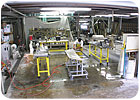
Although Southside Granite has modern machinery in place, handwork remains an important step in the production process.
Challenges
One challenge for Southside Granite has been “finding the right balance between quality and low production costs,” Kingry said. “We simply cannot and will not sacrifice quality of product or customer service, but must constantly battle the rising cost of production at the same time. This is difficult and requires that you constantly re-evaluate everything you do to make sure you’re doing it in the most cost-effective manner. At the same time, you’re always searching for ways to improve the value of the product or the quality of the customer’s buying experience.”Kingry said that another challenging issue is misinformation regarding natural stone in general. “We not only spend our time educating people about the benefits of using natural stone and selecting the right stone for their project, but we also have to negate all the misinformation that is being put out these days,” he said. “It would be good if producers of other surfaces would just stick to promoting what they feel are the advantages of their product without finding it necessary to falsely categorize all natural stones as a maintenance nightmare for homeowners and unfit for the customer’s application.”
The fabricator cited the Stone Fabricators Alliance (SFA) as a source to help unify stoneworking professionals. “It put us in a position to learn from other fabricators and at the same time help educate newcomers to the business - thereby promoting the goodwill of our industry for everyone involved in it,” he said. “We’ve become a participating member, and it’s been more than worth the investment of not only money, but time. A quality job done right and satisfied customers is good for all of us, no matter who produced it. I would also encourage support of MIA, and the work that they do in supporting the entire industry - benefitting members and non-members.”
